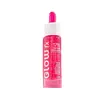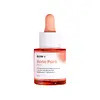What's inside
What's inside
 Key Ingredients
Key Ingredients

 Benefits
Benefits

 Concerns
Concerns

 Ingredients Side-by-side
Ingredients Side-by-side

Water
Skin ConditioningGlycolic Acid
BufferingGluconolactone
Skin ConditioningSodium Hydroxide
BufferingButylene Glycol
HumectantGlycerin
HumectantSodium Lactate
BufferingSodium PCA
HumectantXanthan Gum
EmulsifyingArginine
MaskingSalicylic Acid
MaskingPanthenol
Skin ConditioningPhenoxyethanol
PreservativeAspartic Acid
MaskingAmylopectin
PCA
HumectantDextrin
AbsorbentAllantoin
Skin ConditioningCentella Asiatica Extract
CleansingEpilobium Angustifolium Flower/Leaf/Stem Extract
Skin ConditioningCeramide NP
Skin ConditioningChlorphenesin
AntimicrobialArachidyl Alcohol
EmollientGlycine
BufferingAlanine
MaskingPolygonum Cuspidatum Root Extract
AntioxidantScutellaria Baicalensis Root Extract
AstringentPhytosterols
Skin ConditioningSerine
MaskingStearic Acid
CleansingBehenyl Alcohol
EmollientCarrageenan
Valine
MaskingArachidyl Glucoside
EmulsifyingCamellia Sinensis Leaf Extract
AntimicrobialGlycyrrhiza Glabra Root Extract
BleachingHydrogenated Lecithin
EmulsifyingIsoleucine
Skin ConditioningProline
Skin ConditioningThreonine
Chamomilla Recutita Flower Extract
MaskingRosmarinus Officinalis Leaf Extract
AntimicrobialCyanocobalamin
Skin ConditioningHistidine
HumectantPhenylalanine
MaskingCetearyl Alcohol
EmollientCitric Acid
BufferingWater, Glycolic Acid, Gluconolactone, Sodium Hydroxide, Butylene Glycol, Glycerin, Sodium Lactate, Sodium PCA, Xanthan Gum, Arginine, Salicylic Acid, Panthenol, Phenoxyethanol, Aspartic Acid, Amylopectin, PCA, Dextrin, Allantoin, Centella Asiatica Extract, Epilobium Angustifolium Flower/Leaf/Stem Extract, Ceramide NP, Chlorphenesin, Arachidyl Alcohol, Glycine, Alanine, Polygonum Cuspidatum Root Extract, Scutellaria Baicalensis Root Extract, Phytosterols, Serine, Stearic Acid, Behenyl Alcohol, Carrageenan, Valine, Arachidyl Glucoside, Camellia Sinensis Leaf Extract, Glycyrrhiza Glabra Root Extract, Hydrogenated Lecithin, Isoleucine, Proline, Threonine, Chamomilla Recutita Flower Extract, Rosmarinus Officinalis Leaf Extract, Cyanocobalamin, Histidine, Phenylalanine, Cetearyl Alcohol, Citric Acid
Water
Skin ConditioningCentella Asiatica Leaf Extract
Skin ConditioningNiacinamide
SmoothingCyclopentasiloxane
EmollientDiglycerin
HumectantButylene Glycol
HumectantDimethicone
EmollientPolyglycerin-6
HumectantPEG-8
HumectantAllantoin
Skin ConditioningTocopheryl Acetate
AntioxidantPhenoxyethanol
PreservativeAmmonium Polyacryloyldimethyl Taurate
Emulsion StabilisingHydrolyzed Corn Starch
HumectantPolyacrylamide
Beta Vulgaris Root Extract
Skin ConditioningBakuchiol
AntimicrobialSalicylic Acid
MaskingAminomethyl Propanol
BufferingC13-14 Isoparaffin
EmollientDipotassium Glycyrrhizate
HumectantMethylpropanediol
SolventChlorphenesin
AntimicrobialPropanediol
SolventLauric Acid
CleansingDisodium EDTA
1,2-Hexanediol
Skin ConditioningLactic Acid
BufferingLaureth-7
EmulsifyingLauryl Alcohol Diphosphonic Acid
Emulsion StabilisingIsostearamidopropyl Ethyldimonium Ethosulfate
Sodium Hydroxide
BufferingHylocereus Undatus Fruit Extract
Skin ConditioningScutellaria Baicalensis Root Extract
AstringentBeta Vulgaris Extract
Skin ProtectingCamellia Sinensis Leaf Extract
AntimicrobialGlycyrrhiza Glabra Root Extract
BleachingRosmarinus Officinalis Leaf Extract
AntimicrobialEthylhexylglycerin
Skin ConditioningSodium Benzoate
MaskingCyclotetrasiloxane
EmollientBoswellia Serrata Extract
Skin ConditioningHoney Extract
HumectantOryza Sativa Extract
AbsorbentGlycerin
HumectantPropylene Glycol
HumectantP-Anisic Acid
MaskingOligopeptide-10
Antimicrobial2-Aminobutanol
BufferingCarthamus Tinctorius Seed Oil
MaskingOlea Europaea Fruit Oil
MaskingBromelain
Skin ConditioningPapain
Skin ConditioningWater, Centella Asiatica Leaf Extract, Niacinamide, Cyclopentasiloxane, Diglycerin, Butylene Glycol, Dimethicone, Polyglycerin-6, PEG-8, Allantoin, Tocopheryl Acetate, Phenoxyethanol, Ammonium Polyacryloyldimethyl Taurate, Hydrolyzed Corn Starch, Polyacrylamide, Beta Vulgaris Root Extract, Bakuchiol, Salicylic Acid, Aminomethyl Propanol, C13-14 Isoparaffin, Dipotassium Glycyrrhizate, Methylpropanediol, Chlorphenesin, Propanediol, Lauric Acid, Disodium EDTA, 1,2-Hexanediol, Lactic Acid, Laureth-7, Lauryl Alcohol Diphosphonic Acid, Isostearamidopropyl Ethyldimonium Ethosulfate, Sodium Hydroxide, Hylocereus Undatus Fruit Extract, Scutellaria Baicalensis Root Extract, Beta Vulgaris Extract, Camellia Sinensis Leaf Extract, Glycyrrhiza Glabra Root Extract, Rosmarinus Officinalis Leaf Extract, Ethylhexylglycerin, Sodium Benzoate, Cyclotetrasiloxane, Boswellia Serrata Extract, Honey Extract, Oryza Sativa Extract, Glycerin, Propylene Glycol, P-Anisic Acid, Oligopeptide-10, 2-Aminobutanol, Carthamus Tinctorius Seed Oil, Olea Europaea Fruit Oil, Bromelain, Papain
Ingredients Explained
These ingredients are found in both products.
Ingredients higher up in an ingredient list are typically present in a larger amount.
Allantoin is a soothing ingredient known for its protective and moisturizingg properties. Because of this, it is often added to products with strong active ingredients.
Studies show higher concentrations of this ingredient can promote wound healing.
Though it can be derived from the comfrey plant, allantoin is produced synthetically for cosmetic products to ensure purity.
Learn more about AllantoinButylene Glycol (or BG) is used within cosmetic products for a few different reasons:
Overall, Butylene Glycol is a safe and well-rounded ingredient that works well with other ingredients.
Though this ingredient works well with most skin types, some people with sensitive skin may experience a reaction such as allergic rashes, closed comedones, or itchiness.
Learn more about Butylene GlycolCamellia Sinensis Leaf Extract is derived from the leaves of the tea plant. Black tea, green tea, and oolong tea are all harvested from this plant.
This ingredient has many skin benefits:
This ingredient contains polyphenols, a strong antioxidant. Antioxidants help fight off molecules that damage skin cells.
On top of that, the antioxidants in green tea neutralize free-radicals from the sun. This gives the skin some extra UV protection, but should not replace sunscreen.
Many components of tea have anti-inflammatory properties.
Polyphenols and L-theanine help soothe the skin and reduce irritation. The caffeine in Camellia Sinensis Leaf Extract helps calm inflamed blood vessels.
Other compounds found in tea include: Vitamin Bs, linoleic acid, magnesium, calcium, iron, and zinc.
Research has shown both drinking Camellia Sinensis Leaf Tea and applying it to the skin can help boost skin elasticity and hydration. Studies also show using tea extract may reduce sebum, or oil, production.
Learn more about Camellia Sinensis Leaf ExtractChlorphenesin is a synthetic preservative. It helps protect a product against bacteria in order to extend shelf life. In most cases, Chlorphenesin is paired with other preservatives such as phenoxyethanol and caprylyl glycol.
Chlorphenesin is a biocide. This means it is able to help fight the microorganisms on our skin. It is also able to fight odor-releasing bacteria.
Chlorphenesin is soluble in both water and glycerin.
Studies show Chlorphenesin is easily absorbed by our skin. You should speak with a skincare professional if you have concerns about using Chlorphenesin.
Learn more about ChlorphenesinGlycerin is already naturally found in your skin. It helps moisturize and protect your skin.
A study from 2016 found glycerin to be more effective as a humectant than AHAs and hyaluronic acid.
As a humectant, it helps the skin stay hydrated by pulling moisture to your skin. The low molecular weight of glycerin allows it to pull moisture into the deeper layers of your skin.
Hydrated skin improves your skin barrier; Your skin barrier helps protect against irritants and bacteria.
Glycerin has also been found to have antimicrobial and antiviral properties. Due to these properties, glycerin is often used in wound and burn treatments.
In cosmetics, glycerin is usually derived from plants such as soybean or palm. However, it can also be sourced from animals, such as tallow or animal fat.
This ingredient is organic, colorless, odorless, and non-toxic.
Glycerin is the name for this ingredient in American English. British English uses Glycerol/Glycerine.
Learn more about GlycerinGlycyrrhiza Glabra Root Extract is an extract of the roots of Licorice. It has been found to have several benefits such as skin hydrating, conditioning, and soothing.
One component, glabridin, has extra potent antioxidant and soothing properties. It has also been found to block pigmentation from UVB rays in guinea pigs.
Licorice Root also contains a flavonoid. Flavonoids are a natural substance from in plants. Flavonoids also have antioxidant properties.
Another component, glycyrrhizin, has been found to have anti-inflammatory and antimicrobial benefits. This may make licorice root extract effective at treating acne. However, more research is needed to support this.
Liquiritin is one of the flavone compounds found in licorice. It has been found to help lighten skin by preventing tyrosinase from reacting with tyrosine. When the two react, protein is converted to melanin. Melanin is the substance in your body that gives your features pigmentation.
Learn more about Glycyrrhiza Glabra Root ExtractPhenoxyethanol is a preservative that has germicide, antimicrobial, and aromatic properties. Studies show that phenoxyethanol can prevent microbial growth. By itself, it has a scent that is similar to that of a rose.
It's often used in formulations along with Caprylyl Glycol to preserve the shelf life of products.
Rosmarinus Officinalis Leaf Extract comes from rosemary. Rosemary is native to the Mediterranean.
While Rosmarinus Officinalis Leaf Oil can be volatile due to its fragrant properties, the fragrance components are usually removed in the leaf extract.
Rosemary Leaf Extract contains many antioxidants such as rosmarinic acid and caffeic acid. Rosemarinic acid, a compound found in rosemary leaf, has been found to help soothe skin conditions such as eczema and acne.
Learn more about Rosmarinus Officinalis Leaf ExtractSalicylic Acid (also known as beta hydroxy acid or BHA) is a well-known ingredient for treating skin that struggles with acne and clogged pores. It exfoliates both the skin's surface and deep within the pores to help clear out buildup, control oil, and reduce inflammation.
Unlike AHAs (alpha hydroxy acids), salicylic acid is oil-soluble. This allows it to penetrate into pores which makes it especially effective for treating blackheads and preventing future breakouts.
Salicylic acid is also known for its soothing properties. It has a similar structure to aspirin and can calm inflamed or irritated skin, making it a good option for acne-prone skin that is also sensitive.
Concentrations of 0.5-2% are recognized by the U.S. FDA as an over-the-counter topical acne product.
It can cause irritation and/or dryness if one's skin already has a compromised moisture barrier, so it's best to focus on repairing that before introducing this ingredient into your routine.
While salicylic acid does not increase sun sensitivity, it’s still important to wear sunscreen daily to protect your skin.
If you are looking for the ingredient called BHA or Butylated Hydroxyanisole, click here.
Learn more about Salicylic AcidScutellaria Baicalensis Root Extract comes from the Baikal skullcap or Chinese skullcap plant. This plant is native to Northeast Asia and can be found in China, Mongolia, Korea, and Siberia.
In cosmetics, Scutellaria Baicalensis Root Extract provides antioxidant and anti-inflammatory benefits. This is due to the flavonoid composition of Scutellaria Baicalensis Root Extract.
In Chinese traditional folk medicine, Scutellaria Baicalensis Root Extract is used to help treat lung issues and hypertension.
Learn more about Scutellaria Baicalensis Root ExtractSodium Hydroxide is also known as lye or caustic soda. It is used to adjust the pH of products; many ingredients require a specific pH to be effective.
In small amounts, sodium hydroxide is considered safe to use. However, large amounts may cause chemical burns due to its high alkaline.
Your skin has a natural pH and acid mantle. This acid mantle helps prevent harmful bacteria from breaking through. The acid mantle also helps keep your skin hydrated.
"Alkaline" refers to a high pH level. A low pH level would be considered acidic.
Learn more about Sodium HydroxideWater. It's the most common cosmetic ingredient of all. You'll usually see it at the top of ingredient lists, meaning that it makes up the largest part of the product.
So why is it so popular? Water most often acts as a solvent - this means that it helps dissolve other ingredients into the formulation.
You'll also recognize water as that liquid we all need to stay alive. If you see this, drink a glass of water. Stay hydrated!
Learn more about Water